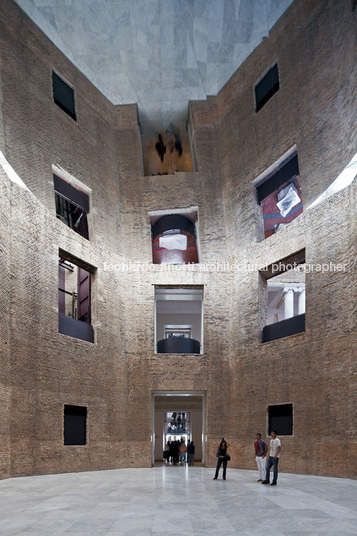olafur eliasson: seu corpo da obra - pinacoteca são paulo sp, brazil
- tech chart
- 17th International Contemporary Art Festival SESC_Videobrasil / São Paulo, Brazil / Produced by: SESC & Associação Cultural Videobrasil / General curator: Solange Farkas / Olafur Eliasson: Your body of work / 30 September 2011 - 29 January 2012 / Curator: Jochen Volz / Three venues in São Paulo: SESC Belenzinho, SESC Pompeia and Pinacoteca do Estado.
- description
From September 30, São Paulo will be hosting Your body of work, the first Olafur Eliasson solo exhibition in South America. Conceived by the artist especially for, and in response to, the Brazilian city, the exhibition features eleven site-specific installations that invite the public to experience perception of color, spatial orientation and other forms of engagement with reality. The exhibition is part of the program for the 17th International Contemporary Art Festival SESC_Videobrasil.
Through to January 2012, Eliasson’s work will fill three venues in São Paulo: the SESC cultural centers in Pompeia and Belenzinho, in the west and east of the city, and the Pinacoteca do Estado, a centennial state-run museum downtown. “The exhibition proposes a grid of experiences based on a temporary geography for São Paulo, creating a series of narratives that converge in the viewer’s experience”, says Jochen Volz, the artistic director of the Inhotim Institute in Minas Gerais and curator of Your body of work.
According to the artist, the title Your body of work touches upon the vital role of the viewer in creating the meanings of the work, at the same time as it underscores the wide-ranging character of the content. “You work your whole life, and everything you do and learn is etched into your body. You are a viewer/producer of history itself, seen as you contribute, or give, more than you receive”, explains Eliasson.
Vibrant City
Eliasson is known for interventions that draw the interest of a wider public beyond the circuits of contemporary art, such as his New York City Waterfalls (2008). He has experimented with propositions that imply increasingly more direct contact with their urban settings. The starting point for the conception of the Brazilian exhibition was the artist’s impressions and curiosities about the different spaces he saw in São Paulo.
“São Paulo is vibrant, it has a very strong physical presence”, says Eliasson. “Though the private sphere remains inaccessible, everything you think and do is perceivable in the streets. In other cities, the public spaces tend to separate very clearly from daily life.” In consonance with the artist’s sensations, the project is drafted as an experience of the city, in dialogue with the architecture of the spaces it occupies.
Three Venues
At SESC Pompeia, a former drum factory transformed into a cultural center in the 1980s, Eliasson’s conceptions are met with the generous spaces the Italo-Brazilian architect Lina Bo Bardi designed for the fruition of the local population. The exhibition, which is spread throughout internal and external areas, was devised to dialogue with the various uses of the venue as a spot for reflection, learning, leisure and entertainment.
A set of works involving colour, light and smoke transforms this 1,500 meter-squared center into a labyrinth of sensorial experiences. In the contiguous exhibition area, configured as a cinema theater, Eliasson plays with the concept of the after image – the counter-image that lingers on the retina when exposed to light – and scenes of São Paulo taken by the Brazilian filmmaker Karim Aïnouz.
At the recently inaugurated SESC Belenzinho, which caters to a region of the city far less privileged in terms of leisure and cultural equipment, Eliasson shows a rotating device that projects light stripes onto the surrounding space. At the Pinacoteca, the work focuses on experiments with one of art’s most classic tools – the mirror – to dialogue with the building’s architecture, originally classical in style but reworked a decade ago by the award-winning architect Paulo Mendes da Rocha.
The Eliasson exhibition will result in an artist book, edited by Jochen Volz, Studio Olafur Eliasson and SESC_Videobrasil. In addition to a photo record of all the works installed and photographic series produced by Eliasson during his field work in São Paulo, the book will also feature essays by Brazilian theorists, establishing relations between different aspects of his work and local production in such fields as art, science and architecture.
Eliasson’s oeuvre will also be the subject of a film in the Videobrasil Authors’ Collection series, which features essayistic documentaries on the work processes of important contemporary artists, such as the South-African William Kentridge, the North-American Coco Fusco and the Brazilian group Chelpa Ferro. Scheduled for release in 2012, the film about Olafur, the seventh in the series, will be directed by the Brazilian filmmaker Karim Aïnouz, known for the films Madame Satã (2004) and O Abismo Preateado, which screened during the Cannes 2011 Directors’ Fortnight.













